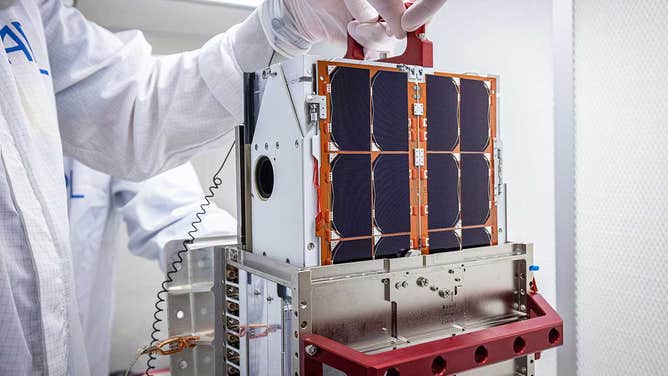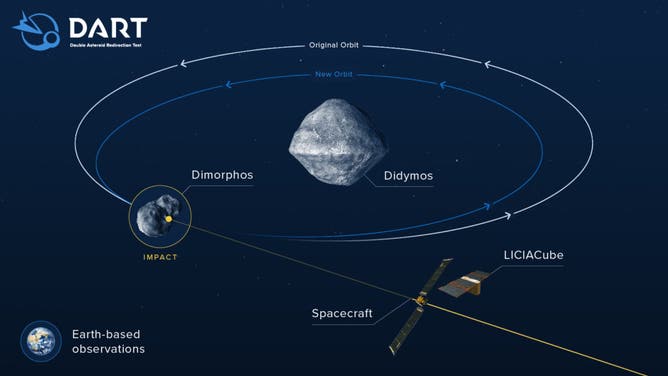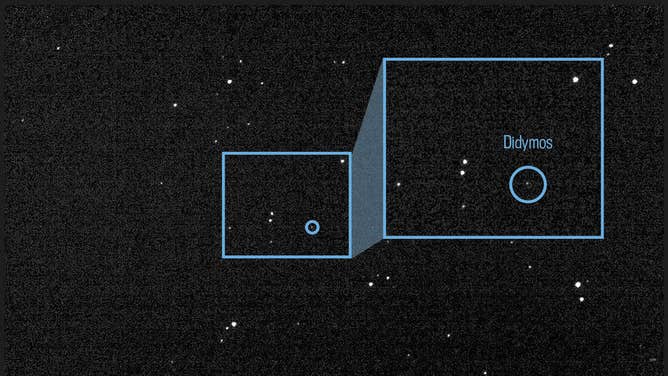Italian satellite will witness NASA DART spacecraft's asteroid smash in the name of planetary defense
CubeSats have helped NASA Mars missions and provided an affordable way for space research. Now, the Italian Space Agency's LICIACube will be witness to the first Earth defense test mission.

DART team engineers lift and inspect the LICIACube CubeSat after it arrived at Johns Hopkins APL in August 2021. The miniaturized satellite deploys 10 days before DART's asteroid impact. (Image Credit: Johns Hopkins APL/Ed Whitman)
NASA's DART spacecraft carried a tiny satellite to witness the smashing end to its life that could lay the groundwork to save Earth when an asteroid is headed this way.
The Double Asteroid Redirect Test (DART) spacecraft is traveling toward a binary asteroidal system – the larger Didymos and its smaller moonlet Dimorphos, about 7 million miles from Earth. The pair of asteroids are considered near-Earth asteroids because their orbit will one day take the asteroids zooming by Earth but are no threat to our planet.
The Johns Hopkins University Applied Physics Laboratory in Maryland manages the spacecraft for NASA, but DART also brought along a companion in the form of a smaller spacecraft built by the Italian Space Agency (Agenzia Spaziale Italiana) called LICIACube, which stands for Light Italian CubeSat for Imaging of Asteroids.
Earlier in September, LICIACube separated from DART and is now flying on its own.
NASA TEAM CONFIDENT IT WILL SUCCESSFULLY KILL ITS DART SPACECRAFT AFTER ASTEROID COLLISION
On Sept. 26, DART is scheduled to hit its target, Dimorphos, just after 7 p.m. ET. DART was not designed to survive this impact. Instead, it will be used as a battering ram to test the kinetic impacter theory as a way to deflect an asteroid when the time comes.
Three minutes after DART makes a direct hit, LICIACube will fly by the asteroid to survey the damage.
Tiny but mighty

This sequence of images from takeoff to landing was taken by the downward-looking navigation camera of NASA’s Ingenuity Mars Helicopter during its ninth flight on Mars on July 5, 2021. (Image: NASA/JPL-Caltech)
CubeSats have come a long way in the last 20 years since the spacecraft design was created to provide affordable access to space for researchers and even young students.
The tiny spacecraft now come in various sizes, some smaller than a shoebox and others as large as a countertop appliance. Each one is packed with enough power, propulsion and technology to collect critical scientific data on a budget.
"I'm very excited that it's out there and flying because we want to see some amazing pictures, some of the last pictures of DART right there from that little CubeSat,"
"One of the biggest surprises in my career is the progress that small spacecraft have made in the last ten years," NASA's associate administrator for science Thomas Zurbuchen said. "Frankly, 10 years ago many people were kind of laughing about small spacecraft in the Science Mission Directorate. We have over 100 of them under development right now, and some of them in the most innovative kind of environments."
IMAGES FROM ASTEROID-SMASHING DART MISSION EXPECTED TO BE 'STUNNING'
LICIACube is another example of going small with significant results. Unlike large rovers and spacecraft the size of small cars that can cost billions of dollars, CubeSats can be built from off-the-shelf hardware for thousands.
NASA's 4-pound Ingenuity helicopter was a demonstration mission that launched with the Perseverance rover. The goal was a single flight, but now the tiny chopper has made over 30 controlled flights on Mars.
In 2018, twin CubeSats called Mars Cube One (MarCO) were used as communications relays for NASA's Mars Insight lander during entry, descent and landing. MarCo would also be the first CubeSats to photograph Mars.
Ten shoebox-size spacecraft will launch along with NASA's Artemis-1 mission around the moon. Each CubeSat is designed with a unique science mission, from surveying the moon for lunar ice to studying a near-Earth asteroid.
LUKE and LEIA acting as the camera crew

DART and LICIACube shown on a graphic with the binary asteroid system Didymos and Dimorphos. (Image: NASA/ JHUAPL)
On Monday, when DART is slated to smash into Dimorphos at 15,000 mph, LICIACube will fly past the crash site. Using two cameras, LUKE and LEIA, the Italian spacecraft will record the impact area, debris, and DART's final moments.
LEIA stands for LICIACube Explorer Imaging for Asteroid and is a narrow field panchromatic camera designed to capture images from a long distance in high resolution. LUKE, also known as the LICIACube Unit Key Explorer, is a wide-field RGB camera that will help scientists analyze the asteroid's environment.
"It's equipped with two cameras that are going to capture direct images of DART's collision and then the ejecta, the pulverized rock that's thrown off during this collision," APL DART coordination lead Nancy Chabot said.
While DART will send back images until the end of its life, LICIACube stores its data instead of sending it back in real time.
According to Chabot, the CubeSat's images of the Dimorphos impact will be sent back in the days, weeks and months following DART's intentional crash.

This image of the light from asteroid Didymos and its orbiting moonlet Dimorphos is a composite of 243 images taken by the Didymos Reconnaissance and Asteroid Camera for Optical navigation (DRACO) on July 27, 2022. (Credits: NASA JPL DART Navigation Team)
If DART hits Dimorphos as planned, this is the best way to test the kinetic impactor Earth defense theory.
DART won't change the orbit of Didymos. It aims to change the speed of the moonlet, Dimorphos, by just a tiny percentage.
WHY 'ARMAGEDDON' PLOT IS NOT EARTH'S BEST DEFENSE FROM ASTEROIDS
"We're moving an asteroid. We are changing the motion of a natural celestial body in space," DART program scientist Tom Statler said. "Humanity has never done that before. And this is stuff of science fiction books and really corny episodes of Star Trek, from when I was a kid."
Scientists using ground-based telescopes and later a European spacecraft will track Dimorphos and Didymos to see if the defense theory was successful.